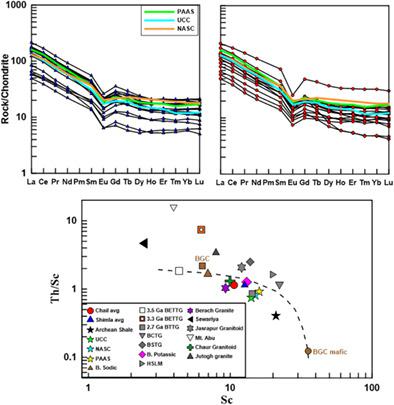当前位置:
X-MOL 学术
›
Geolog. J.
›
论文详情
Our official English website, www.x-mol.net, welcomes your
feedback! (Note: you will need to create a separate account there.)
Geochemistry of meta-sediments from Neoproterozoic Shimla and Chail Groups of Outer Lesser Himalaya: Implications for provenance, tectonic setting, and paleo-weathering conditions
Geological Journal ( IF 1.4 ) Pub Date : 2021-06-06 , DOI: 10.1002/gj.4183 Kumar Batuk Joshi 1 , Soumya Ray 2 , Talat Ahmad 2, 3 , Satyanarayanan Manavalan 4 , Keshav Krishna Aradhi 4
Geological Journal ( IF 1.4 ) Pub Date : 2021-06-06 , DOI: 10.1002/gj.4183 Kumar Batuk Joshi 1 , Soumya Ray 2 , Talat Ahmad 2, 3 , Satyanarayanan Manavalan 4 , Keshav Krishna Aradhi 4
Affiliation

|
The depositional history of the Himalayas has been overprinted by the tectonic activities during the Himalayan Orogeny. A detailed investigation of the sedimentary units can provide crucial information regarding their depositional history and provenance. This study aims at constraining the weathering history, tectonic setting, and provenance of meta-sediments from the Shimla and Chail Groups of Outer Lesser Himalaya. With similar major element chemistry, these meta-sediments comprise a low-silica group (avg. SiO2/Al2O3 <3.29). Weathering intensity parameters chemical index of alteration (CIA), plagioclase index of alteration (PIA) and index of chemical variability (ICV) range from 62 to 78 (avg. = 69.41), 70 to 96 (avg. = 85.34), and 0.45 to 1.45 (avg. = 1.01), respectively indicating moderate to severe degrees of weathering. Transition element ratios [Cr/V (1.68–5.18), Ni/Co (1.47–30.99), and V/Ni (0.87–4.61)], and trace element bivariate plots suggest a recycled, felsic to intermediate provenance that has primarily been derived from Post-Archean sources with minor inputs from Archean units. A passive margin depositional setting with arc-derived sources is suggested for the Chail and Shimla meta-sediments. Rare-earth element patterns reveal similarities between the studied metasediments with TTG gneisses and sanukitoids from the Aravalli and Bundelkhand Cratons, as well as Chaur and Jutogh granitoids. Therefore, Neoproterozoic Himalayan granitoids and Archean Aravalli-Bundelkhand granitoids (TTGs and high-K granitoids) could be potential sources of these meta-sediments, as also suggested by the detrital zircon age distribution from the Beas-Satluj-Pabbar valleys and Shimla Group.
中文翻译:

外小喜马拉雅新元古代 Shimla 和 Chail 群变质沉积物的地球化学:对物源、构造环境和古风化条件的影响
喜马拉雅山脉的沉积历史已被喜马拉雅造山运动期间的构造活动所覆盖。对沉积单元的详细调查可以提供有关其沉积历史和来源的重要信息。本研究旨在限制来自外小喜马拉雅山的 Shimla 和 Chail 群的变质沉积物的风化历史、构造环境和来源。具有相似的主要元素化学,这些超沉积物包含低硅基团(平均 SiO 2 /Al 2 O 3 <3.29)。风化强度参数化学蚀变指数 (CIA)、斜长石蚀变指数 (PIA) 和化学变异性指数 (ICV) 范围从 62 到 78(平均 = 69.41)、70 到 96(平均 = 85.34)和 0.45至 1.45(平均值 = 1.01),分别表示中度至重度风化。过渡元素比率 [Cr/V (1.68–5.18)、Ni/Co (1.47–30.99) 和 V/Ni (0.87–4.61)] 和微量元素双变量图表明一个回收的、长英质到中间的出处,主要是来自太古代后的来源,而太古代单位的少量输入。对于 Chail 和 Shimla 变质沉积物,建议采用弧源的被动边缘沉积环境。稀土元素模式揭示了所研究的变沉积物与来自 Aravalli 和 Bundelkhand 克拉通的 TTG 片麻岩和 sanukitoid 以及 Chaur 和 Jutogh 花岗岩之间的相似性。因此,新元古代喜马拉雅花岗岩和太古宙 Aravalli-Bundelkhand 花岗岩(TTG 和高 K 花岗岩)可能是这些变质沉积物的潜在来源,Beas-Satluj-Pabbar 山谷和 Shimla 群的碎屑锆石年龄分布也表明了这一点。
更新日期:2021-06-06
中文翻译:

外小喜马拉雅新元古代 Shimla 和 Chail 群变质沉积物的地球化学:对物源、构造环境和古风化条件的影响
喜马拉雅山脉的沉积历史已被喜马拉雅造山运动期间的构造活动所覆盖。对沉积单元的详细调查可以提供有关其沉积历史和来源的重要信息。本研究旨在限制来自外小喜马拉雅山的 Shimla 和 Chail 群的变质沉积物的风化历史、构造环境和来源。具有相似的主要元素化学,这些超沉积物包含低硅基团(平均 SiO 2 /Al 2 O 3 <3.29)。风化强度参数化学蚀变指数 (CIA)、斜长石蚀变指数 (PIA) 和化学变异性指数 (ICV) 范围从 62 到 78(平均 = 69.41)、70 到 96(平均 = 85.34)和 0.45至 1.45(平均值 = 1.01),分别表示中度至重度风化。过渡元素比率 [Cr/V (1.68–5.18)、Ni/Co (1.47–30.99) 和 V/Ni (0.87–4.61)] 和微量元素双变量图表明一个回收的、长英质到中间的出处,主要是来自太古代后的来源,而太古代单位的少量输入。对于 Chail 和 Shimla 变质沉积物,建议采用弧源的被动边缘沉积环境。稀土元素模式揭示了所研究的变沉积物与来自 Aravalli 和 Bundelkhand 克拉通的 TTG 片麻岩和 sanukitoid 以及 Chaur 和 Jutogh 花岗岩之间的相似性。因此,新元古代喜马拉雅花岗岩和太古宙 Aravalli-Bundelkhand 花岗岩(TTG 和高 K 花岗岩)可能是这些变质沉积物的潜在来源,Beas-Satluj-Pabbar 山谷和 Shimla 群的碎屑锆石年龄分布也表明了这一点。











































 京公网安备 11010802027423号
京公网安备 11010802027423号